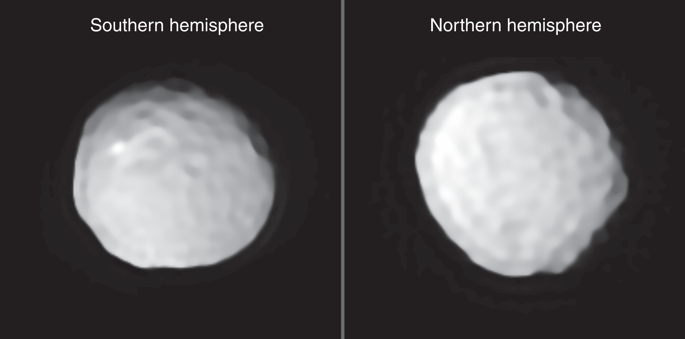Nature Astronomy ( IF 12.9 ) Pub Date : 2020-02-10 , DOI: 10.1038/s41550-019-1007-5 Michaël Marsset , Miroslav Brož , Pierre Vernazza , Alexis Drouard , Julie Castillo-Rogez , Josef Hanuš , Matti Viikinkoski , Nicolas Rambaux , Benoît Carry , Laurent Jorda , Pavel Ševeček , Mirel Birlan , Franck Marchis , Edyta Podlewska-Gaca , Erik Asphaug , Przemyslaw Bartczak , Jérôme Berthier , Fabrice Cipriani , François Colas , Grzegorz Dudziński , Christophe Dumas , Josef Ďurech , Marin Ferrais , Romain Fétick , Thierry Fusco , Emmanuel Jehin , Mikko Kaasalainen , Agnieszka Kryszczynska , Philippe Lamy , Hervé Le Coroller , Anna Marciniak , Tadeusz Michalowski , Patrick Michel , Derek C. Richardson , Toni Santana-Ros , Paolo Tanga , Frédéric Vachier , Arthur Vigan , Olivier Witasse , Bin Yang

|
Asteroid (2) Pallas is the largest main-belt object not yet visited by a spacecraft, making its surface geology largely unknown and limiting our understanding of its origin and collisional evolution. Previous ground-based observational campaigns returned different estimates of its bulk density that are inconsistent with one another, one measurement1 being compatible within error bars with the icy Ceres (2.16 ± 0.01 g cm−3)2 and the other3 compatible within error bars with the rocky Vesta (3.46 ± 0.03 g cm−3)4. Here we report high-angular-resolution observations of Pallas performed with the extreme adaptive optics-fed SPHERE imager5 on the Very Large Telescope. Pallas records a violent collisional history, with numerous craters larger than 30 km in diameter populating its surface and two large impact basins that could be related to a family-forming impact. Monte Carlo simulations of the collisional evolution of the main belt correlate this cratering record to the high average impact velocity of ~11.5 km s−1 on Pallas—compared with an average of ~5.8 km s−1 for the asteroid belt—induced by Pallas’s high orbital inclination (i = 34.8°) and orbital eccentricity (e = 0.23). Compositionally, Pallas’s derived bulk density of 2.89 ± 0.08 g cm−3 (1σ uncertainty) is fully compatible with a CM chondrite-like body, as suggested by its spectral reflectance in the 3 μm wavelength region6. A bright spot observed on its surface may indicate an enrichment in salts during an early phase of aqueous alteration, compatible with Pallas’s relatively high albedo of 12–17% (refs. 7,8), although alternative origins are conceivable.
中文翻译:

水相演化的猛烈碰撞史(二)帕拉斯
小行星 (2) Pallas 是尚未被航天器访问过的最大的主带天体,这使得它的表面地质在很大程度上未知,并限制了我们对其起源和碰撞演化的理解。以前的地面观测活动返回了对其体积密度的不同估计,这些估计彼此不一致,一个测量值1在误差条内与冰冷的谷神星 (2.16 ± 0.01 g cm -3 ) 2兼容,另外3 个在误差条内兼容与岩石灶神星 (3.46 ± 0.03 g cm -3 ) 4。在这里,我们报告了使用极端自适应光学馈电 SPHERE 成像器5对 Pallas 进行的高分辨率观测在甚大望远镜上。帕拉斯记录了一段剧烈的碰撞历史,其表面有许多直径超过 30 公里的陨石坑和两个可能与形成家族的撞击有关的大型撞击盆地。主带碰撞演化的蒙特卡洛模拟将这一陨石坑记录与帕拉斯上约 11.5 km s -1的高平均撞击速度相关,而小行星带的平均撞击速度为约 5.8 km s -1 - 由 Pallas 引起高轨道倾角 ( i = 34.8°) 和轨道偏心率 ( e = 0.23)。在成分上,帕拉斯推导出的堆积密度为 2.89 ± 0.08 g cm -3 (1 σ不确定性)与 CM 球粒陨石样体完全兼容,如其在 3 μm 波长区域6的光谱反射率所示。在其表面上观察到的一个亮点可能表明在水性蚀变的早期阶段盐的富集,这与帕拉斯相对较高的 12-17% 的反照率相一致(参考文献7,8),尽管可以想象其他来源。











































 京公网安备 11010802027423号
京公网安备 11010802027423号